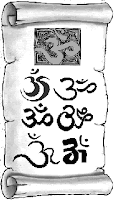Hari OM
'Text-days' are for delving into the
words and theory of Advaita Vedanta.
TATTVABODHAH.
[You are reminded that reviewing the
previous week's posts will become essential as the meanings of the Sanskrit
terms may not be repeated. There may come additional or alternative meanings,
but all should be noted. As study progresses, the technical terms must
necessarily become 'second nature' to the student. When the Sanskrit is used,
the translation will fall easily into place - or likewise, if the English is
used, the Sanskrit term must easily come forwards.]
Please revisit THIS post and chant the mangala-charana. Please use the
TattvabodaH label to access all posts relevant to this text.
(The vid-clip includes chanting for next week's lesson also, as each chant is relatively brief.)
पञ्च-कोशाः /pancha-koshaaH - the five sheaths,
cont'd.
प्राणमय कोशाः /praanamaya koshaaH - the vital airs
sheath.
प्राणमयः कः
प्राणाद्याः पञ्चवायवः
वागादीन्द्रियपञ्चकं प्राणमयः कोशः।
praaNamayaH
kaH
praaNaadyaaH
pa~nchavaayavaH
vaagaadIndriyapa~ncakaM
praaNamayaH koshaH.
"what is praanamayaH ?"
"The five physiological
functions like praana and so on; and the five organs of action, like speech and
so on; together form the vital air sheath."
The vital air sheath pervades the food sheath. It is subtler. The
five modifications of air which control the main physiological functions of the
body are called praanas. In brief they are;
Praana; respiration; breathing is
governed by this. When the inhalation and exhalation are slow, deep, rhythmic
and even, then the breathing is proper and good.
Apaana; elimination; waste removal.
Were it not for its efficient functioning, toxic chemicals and waste would
gather in the body, resulting in poor health.
Samaana; digestion; the transformation of gross food into its nutrient constituents for the body to utilise.
Samaana; digestion; the transformation of gross food into its nutrient constituents for the body to utilise.
Vyaana; circulation; this is not just
the oxygenation of the blood, but also other circulations in the body,
providing nourishment and protection to the body.
Udaana; 'reversings'; as in forcible
ejection. All reactions or reverse process are governed by this praana - eg
vomiting, burping, crying, sneezing. It
is responsible for the mind rejecting one thought and taking another. It
supplies the power for the subtle body to leave the gross body at time of
death.
The pancha-praaana are vital to life. They function silently from
birth to death even while we sleep. If
even one is not working at full function, we become ill and even may face
death. Praanas are the connecting factor of the subtle body with the gross
body. It is for this reason that there
is an entire school in the shaastra for praanaayaama - the physical yoga with which many are familiar.
Normally the praanas function naturally and involuntarily (though it
is known that advanced yogis are able to exert mind control over the praanas).
It can be seen now how the various organs of action can only function in their
turn as a result of the presence of the praanas. When the Self identifies with
this kosha, it will say '"I" am hungry, "I" am thirsty' and
so on.
If this explanation seems brief, be reminded that, although subtle,
praana is still considered very much of the physical realm and again, whilst
Vedanta addresses them in order to give a context for the physical 'Self', it
does not linger. However, fret not, for the subject will keep being revisited
with ever more depth of understanding developing.

